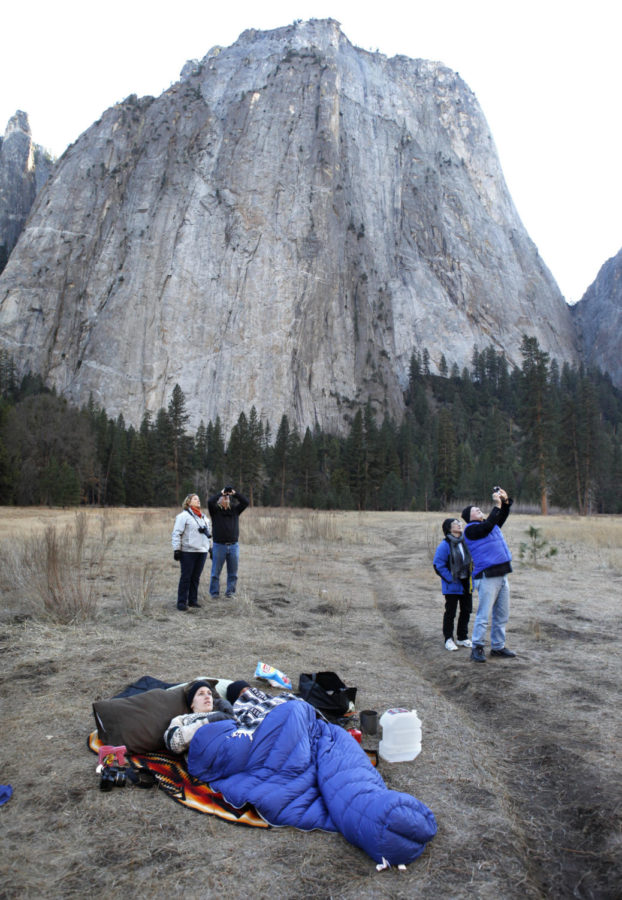Climbing “The Dawn Wall”
Onlookers watch climbers Kevin Jorgeson and Tommy Caldwell as they attempt to ascend the Dawn Wall of El Capitan on Jan. 13, 2015 in Yosemite National Park, Calif., which is the event on which the documentary is based (Patrick Tehan/Tribune News Service).
April 9, 2019
You may have heard of the Academy Award winning documentary “Free Solo,” which follows rock climber Alex Honnold on his attempt to “free solo” climb El Capitan—a prestigious mountain in Yosemite National Park. While preparing for his solo ascent, Honnold went through practice climbs with fellow climber Tommy Caldwell, who completed his own big climb up the Dawn Wall in 2015.
“The Dawn Wall” released on Sep. 14, 2018, came to Netflix on Tuesday, March 5. This documentary follows Caldwell as he sets out to conquer his own mountain—free climbing the 3,000 foot Dawn Wall of El Capitan. Free climbing is a style of rock climbing that doesn’t use equipment besides the ropes that are there only to catch you if you fall off the wall. Caldwell new he needed a partner to help him achieve this lofty goal, which ended up being Kevin Jorgeson, a climber known for being able to “high ball” large boulders without ropes.
Caldwell and Jorgeson set out to climb the Dawn Wall in a single push (meaning that they lived off the wall until they completed the climb), ultimately staying on the side of “El Cap” for 19 days. This documentary follows their grueling attempt while also providing interviews and insight into their personal thoughts and daily life on the wall. While the production quality is not as good as “Free Solo,” “The Dawn Wall” certainly makes up for it in storytelling and reporting. The interviews include Caldwell’s family members, as well as climber and author John Long, who narrates and explains the more technical aspects and jargon that would otherwise go over the heads of most viewers.
The movie is definitely moving the same way as Free Solo and other climbing documentaries are. I became more and more invested with each pitch that they conquered and with each interview that gave more depth into the climbers’ backgrounds. In one of the first scenes of the film, Caldwell describes going to Kyrgyzstan with girlfriend Beth Rodden and two other climbers to experience climbing the elite-level peaks. While there, all four are captured as prisoners of war and held hostage for six days. At that point, one of the captors takes the prisoners hiking on a mountain and Caldwell pushes him off the side, in order to save himself and his friends. This film is able to touch on this extremely deep topic that emotionally affected Caldwell. He developed depression and his wife, Rodden, divorces him, two things that motivate him to return to his former passion—climbing. This insight is crucial to the development of the story and the viewers’ perception of Caldwell. Without it, Caldwell’s journey would seem foolish, like he was throwing his life away. When in reality, this quest allowed him to focus and return to a sense of normalcy.
I enjoyed watching this movie from beginning to end and recommend it to anyone who enjoyed “Free Solo” or just wants to watch an uplifting story about a lifeline goal that is conquered. Just like cheering on a March Madness game, this film allows you to get emotionally attached to the journey the two climbers take on.“The Dawn Wall” was very enjoyable to watch and left me feeling inspired and ready to take on my own mountain.





















![Movie poster for '[Rec]" (2007).](https://www.lionnewspaper.com/wp-content/uploads/2023/04/rec-640x900.jpg)



